|
جواب |
رسائل 1 من 14 في الفقرة |
|
Heliópolis
De Wikipedia, la enciclopedia libre
Heliópolis fue una importante ciudad del Antiguo Egipto, capital del nomo XIII del Bajo Egipto.
La ciudad estaba situada al nordeste de la ciudad de El Cairo (cerca del actual aeropuerto), un poco alejada de la ribera occidental del Nilo, a la que estaba conectada mediante un canal.
- Nombre egipcio: Iunu. Nombre griego: Heliópolis. Nombre copto: On.
Su nombre egipcio fue Iunu que significa "pilar". El nombre de Heliópolis es de origen griego: Ἡλίου πόλις o Ἡλίουπόλις y significa "ciudad del Sol", ya que la ciudad era la sede principal del culto al dios solar Ra. Fue una de las tres ciudades más importantes del Antiguo Egipto junto con Tebas y Menfis. Los coptos la conocieron como On.
La ciudad aparece ya nombrada hacia el año 20 a. C. Durante la dinastía II fue un importante centro astronómico. El gran sacerdote tenía el título de Jefe de los observadores. Durante el reinado de Dyeser, este título correspondía a Imhotep.
Es probable que el Templo Solar de Heliópolis fuera similar al tipo de templos solares de Abusir, construidos durante la dinastía V que, hacia el año 2400 a. C. estableció el culto a Ra como culto principal. Se han encontrado restos de la muralla y de algún templo, de los que el principal debía ser el de Amón y el de Ra. Se conserva un obelisco de Senusert I, dinastía XII, así como restos de una capilla de Dyeser. Una estela de la dinastía XVIII conmemoraba el cierre mediante muros del recinto del templo. También se han hallado estatuas y restos de construcciones de la dinastía XIX.
Hacia la mitad del segundo milenio antes de Cristo, la ciudad llegó a su máximo esplendor. Hacia el 1300 a. C. alcanzó su máxima extensión; el declive comienza durante el primer milenio.
Heliópolis fue destruida durante la invasión persa del 525 a. C. y más tarde en el 343 a. C. Tras la fundación de Alejandría, la ciudad quedó marginada y fue despoblándose lentamente. En el siglo I a. C. era ya una ciudad prácticamente deshabitada. En el siguiente siglo, la mayor parte de los monumentos fueron trasladados a Alejandría y Roma. El resto sirvió como cantera de materiales, empleados para construir edificaciones en El Cairo durante la Edad Media.
La zona de Heliópolis fue comprada por una compañía privada a principios del siglo XX y durante el periodo de protectorado británico se construyeron edificios y se repobló con coptos y extranjeros. Con el crecimiento de El Cairo, la capital la incorporó como un barrio más de la ciudad durante la segunda mitad del siglo XX.
Restos arqueológicos[editar]
Enlaces externos[editar]
http://es.wikipedia.org/wiki/Heli%C3%B3polis |
|
|
 أول
أول
 سابق
2 إلى 14 من 14
لاحق
سابق
2 إلى 14 من 14
لاحق
 آخر
آخر

|
|
جواب |
رسائل 2 من 14 في الفقرة |
|
Heliopolis/On

 |

 |
Heliopolis |

obelisk of Heliopolis, Cairo, Egypt. Photo: miriam.mollerus." rel="lightbox[roadtrip]" target="_blank" href="http://looklex.com/e.o/slides/heliopolis01.jpg">
 
The remaining obelisk of Heliopolis, Cairo, Egypt. Photo: miriam.mollerus.

|
Important city in Ancient Egypt, situated right at the apex of the Nile Delta, 8 km east of the river, and about 10 km north of modern Cairo.
 Heliopolis is the Greek name of the city, but several other names were used in different texts: Egyptian theology called it Per-Re ("City of Re," which is the name modeled from the Greek name literally translated, "City of the Sun"), and in the Bible it is called On. Heliopolis is the Greek name of the city, but several other names were used in different texts: Egyptian theology called it Per-Re ("City of Re," which is the name modeled from the Greek name literally translated, "City of the Sun"), and in the Bible it is called On.
 Heliopolis was the centre of sun worship in Egypt. At first it was the god Tem that was revered here, but he was later considered as a form of Re. The temple of Heliopolis was for centuries during the New Kingdom (1570-1085 BCE) among the most important cult centres of Egypt. The temple was second in size only to the Amon temple in Thebes. At its height, the temple employed 13,000 priests and slaves. Heliopolis was the centre of sun worship in Egypt. At first it was the god Tem that was revered here, but he was later considered as a form of Re. The temple of Heliopolis was for centuries during the New Kingdom (1570-1085 BCE) among the most important cult centres of Egypt. The temple was second in size only to the Amon temple in Thebes. At its height, the temple employed 13,000 priests and slaves.
 Heliopolis was also the main centre in Egypt for the writing of religious literature. Heliopolis was also the main centre in Egypt for the writing of religious literature.
 Today there is little left of the city, the obelisk (see illustration) of Sesostris 1 being the only remaining monument. One other obelisk now stand on the Thames embankment in London, United Kingdom, and another in Central Park, New York, USA. Today there is little left of the city, the obelisk (see illustration) of Sesostris 1 being the only remaining monument. One other obelisk now stand on the Thames embankment in London, United Kingdom, and another in Central Park, New York, USA.
History2900 BCE: First historical traces of Heliopolis. Around 2400: Heliopolis rises to great fame, after the priests at the temple of Re succeeds in making the cult of Re the state religion. 1500: Heliopolis reaches its historical height, when Re (later changed into Amon-Re) started to be revered as the chief god in the Egyptian pantheon. Around 1300: During the reign of Ramses 2, the temple of Heliopolis reaches its maximum size. From around 1000: Slow decline for Heliopolis starts. From 332: After the founding of Alexandria in 332, Heliopolis is forgotten by the rulers of Egypt. From 30: With the Roman invasion of Egypt, most of the obelisks of Heliopolis are removed. The walls of the city are used for the construction of other cities.
|
|
|
|
جواب |
رسائل 3 من 14 في الفقرة |
|
El Área de la antigua Heliópolis (On) Hoy
Vida moderna de la antigua Heliópolis – por Jimmy Dunn

El antiguo Heliópolis se encuentra en el extremo noreste del Cairo mayor en un distrito conocido como Mataria o Matariya. Durante años, por su alejada localización no era frecuentado por turistas. En efecto, lo más interesante que podía ser visitado era un un Obelisco de granito rojo, que pertenecía a Senusret I (seguramente la más antigua Egipto, la cual originalmente se encontraba con su gemelo del Templo de Amón), algunas tumbas en la zona y para los exploradores cristianos, en las inmediaciones podrán encontrar el árbol de la Santísima Virgen. Hoy en día, el Consejo Supremo de Antigüedades (SCA) se encuentra en proceso de desarrollar el sector, lo que seguramente hará de éste un espacio con mayor afluencia turística.
No fue sino hasta el periodo del actual presidente de la SCA, Zahi Hawass, que se comenzó a prestar una especial atención a esta locación. Durante la época faraónica, el antiguo On - y posteriormente conocido por los griegos como Heliópolis, era el centro del culto solar, un centro religioso y tal vez una de las tres ciudades más importantes del antiguo Egipto. Heliópolis fue el hogar de Ra, el dios sol, así como Atum, al tiempo que fue considerado como el punto del cual la creación del mundo inició. En este lugar existía un gran templo del sol que posiblemente habría hecho parecer minúsculo el gran Templo de Amón en el complejo de Karnak en Luxor (antigua Tebas).

Mapa del área del antiguo Heliópolis (arriba)
Por ejemplo, sabemos gracias a algunos registros de las dimensiones de los muros del recinto principal en el templo de Heliópolis. Estos generalmente, tomaban la forma de un trapecio de unos 1.200 metros de oeste a este, y 1.000 metros de norte a sur.

Aunque algunos fragmentos aun se conservan, éstos eran bastante apreciados al momento de la expedición francesa, incluso en 1898, algunas secciones de estas paredes se encontraban todavía de pie a unos diez – doce metros de altura. Se sabe también que gracias a la estela funeraria de un cierto Djedatumiufankh ubicada no muy lejos del lugar, que el espesor de las paredes era excepcional para un sitio Saíta. En este texto autobiográfico, se mencionan dimensiones de alrededor de 15,6 metros de espesor. Ahora considera que las paredes externas del templo de Amón en Karnak sólo miden 480 por 550 metros, y ni siquiera tenían doce metros de espesor.
Por desgracia, el templo en toda su extensión desapareció hace mucho tiempo, y la posterior expansión urbana del Cairo ha envuelto casi todo lo pudo haber quedado. De hecho, la ciudad fue incendiada, probablemente por el conquistador persa Cambises, y según el historiador griego Estrabón, se encontraba en ruinas para el año 24 antes de Cristo.
No fue sino hasta la década de 1950 que el Departamento de Antigüedades encargó a un alemán en principio levantar el obelisco en este lugar. Posteriormente, a mediados de la década de 1970, se continuaron los esfuerzos por mejorar los alrededores del obelisco así como las inmediaciones del Árbol de la Virgen, sin embargo el lugar continuaba con una carencia de rutas de acceso lo que dificultaba el tránsito de turistas, hasta que un nuevo puente fue construido sobre la estación de tren que separa El Cairo de Matariya.

Aun así, el sitio continuó recibiendo poca atención hasta que, en 1993 mientras se llevaba a cabo la excavación de un sistema de cimentación y drenaje para una casa nueva cerca del obelisco de granito, un conjunto de estatuas de piedra caliza, granito y sarcófagos fueron encontrados. Su tamaño y decoraciones sugerían su carácter real o perteneciente a funcionarios de muy alto rango de de la dinastía 26 en el periodo Saíta, contemporánea a la tumba de Baneshi, el gobernante saíta del Bajo Egipto (595-589 aC). En aquel momento, estos artefactos fueron limpiados y arreglados en un pequeño museo al aire libre relativo al obelisco.
En 2001, otro descubrimiento fue realizado cuando una solicitud para una inspección arqueológica fue hecha antes de construir otra casa. Esta investigación desembocó en el descubrimiento de la tumba de WAJA-Hur, un reconocido constructor y arquitecto de la Dinastía 26. Esta era una tumba bastante elaborada que constaba de dos largos pasillos que conducían a tres cámaras funerarias. La tumba estaba desprovista de elementos característicos de un rito funerario, excepto por 29 figuras shawabtis que llevaban el nombre del dueño de la tumba. Sin embargo, la tumba estaba decorada con los textos funerarios y relieves de colores, pero porque se encontraba a unos 10 metros bajo el nivel del suelo, se inundó parcialmente. Desde entonces, se han hecho esfuerzos para proteger esta tumba de las aguas subterráneas y restaurar sus murallas. De hecho, la tumba fue reconstruida en un lugar seco y sobre el nivel del agua subterránea al tiempo que alrededor de ésta fue desarrollado un nuevo museo al aire libre.

Lugar donde se ubicó el museo al aire abierto, en construcción
Aquí, podrán encontrar un recorrido turístico que comienza en el coloso, conduce a la tumba de Baneshi y la colección de sarcófagos de granito; a continuación se dirigen hacia la tumba .de WAJA-Hur. Fuera del museo los visitantes son guiados hacia el árbol de la Virgen, un plátano que se dice fue plantado en 1672 sobre uno más viejo. Según la Tradición cristiana cóptica, la Sagrada Familia en su viaje a través de Egipto descansaba debajo de este árbol después de cruzar el desierto, y sigue siendo un lugar de peregrinación. Los visitantes terminarán su aventura en el ahora famoso obelisco.

El museo incluye varios cuadros, estatuas y fragmentos de un obelisco que perteneció a Tutmosis II pero superpuestas por inscripciones de Ramsés II, así como objetos que llevan los nombres de Amenhotep II, Tutmosis IV y Amenhotep III. Aquí se puede encontrar El Naos tallados en cuarcita roja de Tutmosis II de la cantera de Gebel Ahmar. Entre otros objetos podrán encontrar a los pies del obelisco de Sesostris, la parte superior de un obelisco de cuarcita pequeño que parece llevar el nombre de Teti, faraón de la dinastía sexta de Egipto. Podrá de igual forma encontrarse la base de un gran obelisco in situ, junto con unos pocos bloques de granito, que presumiblemente pertenecían a la Dinastía 18. En la esquina sureste del parque museo puede encontrarse otro pequeño museo con otros objetos más pequeños.

Pintura funeraria en Heliópolis
Casi la mitad de los obeliscos que fueron llevados a Roma provenían de Heliópolis, y se dice que el hogar de los emperadores y los papas en algún momento contó con hasta cuarenta y ocho obeliscos. La antigua Heliópolis debió haber sido un lugar maravilloso, situado en un lugar afortunado en algún momento por su gloria pero lamentable por su precaria preservación.
| Título |
Autor |
Fecha |
Editorial |
Número de Referencia |
| Ancient Gods Speak, The: A Guide to Egyptian Religion |
Redford, Donald B. |
2002 |
Oxford University Press |
ISBN 0-19-515401-0 |
| Atlas of Ancient Egypt |
Baines, John; Malek, Jaromir |
1980 |
Les Livres De France |
None Stated |
| Cairo: An Illustrated History |
Raymond, Andre, Editor |
2002 |
Rizzoli, New York |
ISBN 0-8478-2500-0 |
| Complete Gods and Goddesses of Ancient Egypt, The |
Wilkinson, Richard H. |
2003 |
Thames & Hudson, LTD |
ISBN 0-500-05120-8 |
| Complete Temples of Ancient Egypt, The |
Wilkinson, Richard H. |
2000 |
Thames and Hudson, Ltd |
ISBN 0-500-05100-3 |
| Dictionary of Ancient Egypt, The |
Shaw, Ian; Nicholson, Paul |
1995 |
Harry N. Abrams, Inc., Publishers |
ISBN 0-8109-3225-3 |
| Dictionary of Egyptian Gods and Goddesses, A |
Hart, George |
1986 |
Routledge |
ISBN 0-415-05909-7 |
| History of Ancient Egypt, A |
Grimal, Nicolas |
1988 |
Blackwell |
None Stated |
| Holy Family in Egypt, The |
Unknown |
1999 |
United Printing Publishing & Distributing Co. |
None Stated |
Read more: http://www.touregypt.net/es/featurestories/on.htm#ixzz33UosHHLM
|
|
|
|
جواب |
رسائل 4 من 14 في الفقرة |
|
Encyclopedia
HELIOPOLIS
he-li-op'-o-lis.
See ON.
ON (1)
on ('on; Egyptian An, Ant, Annu, probably pronounced An only, as this is often all that is written, a "stone" or "stone pillars"): Later called Hellopolis. The name On occurs only in Genesis 41:45, 50; Genesis 46:20. It occurs in one other place in the Septuagint (Exodus 1:11), where On is mentioned with Pithom and Raamses as strong cities which the Israelites built. Hebrew slaves may have worked upon fortifications here, but certainly did not build the city. On is possibly referred to as `ir ha-herec, in Isaiah 19:18 (see IR-HA-HERES). On may also be mentioned by Jeremiah (43:13) under the name Beth-shemesh. Ezekiel speaks of an Aven ('awen) (Ezekiel 30:17), where it is mentioned with Pibeseth (Bubastis). Aven in this passage is almost certainly the same as On in Genesis 41:45; Genesis 46:20, as the letters of both words are the same in the Hebrew. Only the placing of the vowel-points makes any difference. If there is a mistake, it is a mistake of the Massoretes, not of the Hebrew writer.
1. Location and Description:
There were two Ons in Egypt: one in Upper Egypt, An-res (Hermonthis); the other in Lower Egypt, An-Meheet (Brugsch, Geogr. Inschr., 254, 255, numbers 1217, a, b, 1218, 8708, 1225). The latter is the On referred to in the Bible. It lay about 20 miles North of the site of old Memphis, about 10 miles Northeast of the location of modern Cairo. It has left until this time about 4 square miles of ruins within the old walls. Little or nothing remains outside the walls.
On was built at the edge of the desert, which has now retreated some 3 or 4 miles eastward, the result of the rising of the bed of the Nile by sediment from the inundation, and the broadening of the area of infiltration which now carries the water of the Nile that much to the East. The land around On has risen about 10 ft., and the waters of infiltration at the time of lowest Nile are now about 1 1/2 ft. above the floor-level of the temple.
2. History:
The history of On is very obscure, yet its very great importance is in no doubt. No clear description of the ancient city or sanctuary has come down to us, but there are so many incidental references, and so much is implied in ancient records, that it stands out as of the very first importance, both as capital and sanctuary. The city comes from the Ist Dynasty, when it was the seat of government, and indeed must have been founded by the Ist Dynasty or have come down to it from pre-historic time. From the IIIrd to the VIth Dynasty the seat of government was shifted from On to Memphis, and in the XIIth Dynasty to Diospolis. Throughout these changes On retained its religious importance. It had been the great sanctuary in the time of the Pyramid Texts, the oldest religious texts of Egypt, and judging from the evident great development of the temple of On at the time of the writing of the texts, the city must have antedated them by considerable time (Budge, History of Egypt, II, 83, 84, 108; Breasted, Development of Religion and Thought in Egypt, chapters i, ii). The myth of Osiris makes even the charge against Set for the murder of Osiris to have been preferred at Heliopolis (Breasted, op. cit., 34). This certainly implies a very great age for the sanctuary at On. It contained a temple of the sun under the name Ra, the sun, and also Atum, the setting sun, or the sun of the Underworld. There was also a Phoenix Hall and asacred object called a ben, probably a stone, and the origin of the name An, a "stone" or "pillar" (compare Breasted, op. cit., 76, 11, and 71). Though the XIIth Dynasty removed the capital to Diospolis, Usertsen I (Senwesret) of that Dynasty erected a great obelisk at On in front of the entrance to the temple. The situation of this obelisk in the templearea indicates that the great temple was already more than a half-mile in length as early as the XIIth Dynasty. The mate of this obelisk on the opposite side of the entrance seems not to have been erected until the XVIIIth Dynasty. Its foundations were discovered in 1912 by Petrie. Some scraps of the granite of the obelisk bear inscriptions of Thothmes III. A great Hyksos wall, also discovered by Petrie in 1912, exactly similar to that of the fortified camp at Tel el Yehudiyeh, 4 miles North, makes it quite certain that these usurpers between the Old Empire and the New fortified On as the capital once more. The manifest subserviency of the priests of On in the story of Joseph makes it most probable that the old capital at On had already been subjugated in Joseph's time, and that within this old fortification still existing Joseph ruled as prime minister of Egypt. Merenptah in his 5th year began to fortify On. Sheshonk III called himself "divine prince of Annu," and seems to have made On one of the greatest sanctuaries of his long reign. On still figured in Egyptian history in the rebellion against Ashurbanipal. The city has been deserted since the Persian invasion of 525 B.C. Tradition makes the dwelling-place of Joseph and Mary with the child Jesus, while in Egypt, to have been near Heliopolis.
The exploration of On was attempted by Schiaparelli, but was not carried out, and his work has not been published. In 1912 Petrie began a systematic work of excavation which, it is expected, will continue until the whole city has been examined. The only great discovery of the first season was the Hyksos wall of fortification. Its full import can only be determined by the continuance of the exploration.
M. G. Kyle
|
|
|
|
|
جواب |
رسائل 5 من 14 في الفقرة |
|
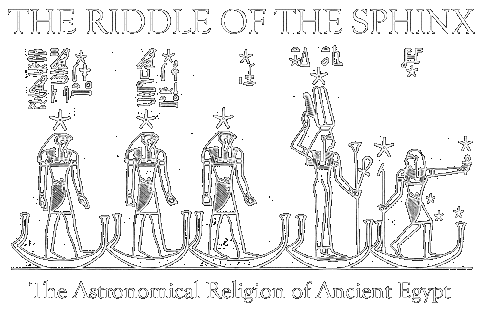

Editorial | Fragments | Cahokia I | Piasa Creature I | Sphinx II
Questions? Comments? Suggestions? Contact us!
Register for our Hall of Records Newsletter!
Questions? Comments? Suggestions? Advertising? Press Releases? Contact us!
The Riddle of the Sphinx Part I | Part II | Part III | Part IV
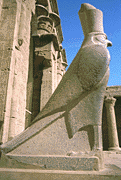 |
|
Horus, son of Osiris, in his hawk aspect. One of the most important deities in ancient Egyptian religion, the Pharaoh was considered the incarnation of Horus, and the inheritor of the kingdom of Osiris.
|
 gyptian religion, like every other ancient religion, was a religion filled with myths and magic, gods, and demigods. However, despite the multiplicity of deities in their ancient religion, and the prominence of fertility rituals in Egyptian rite and cult, the central basis of ancient Egyptian religion was not sexuality, but astronomy. Though sexuality would later come to dominate Egyptian religion, as ignorance and decadence slowly infected the ancient wisdom of Egypt, ancient Egyptian religion was, at its core, astronomical. All the priests of ancient Egypt were master astronomers, as all the deities of ancient Egypt found their homes not only on Earth, but also in the heavens, in the form of constellations. gyptian religion, like every other ancient religion, was a religion filled with myths and magic, gods, and demigods. However, despite the multiplicity of deities in their ancient religion, and the prominence of fertility rituals in Egyptian rite and cult, the central basis of ancient Egyptian religion was not sexuality, but astronomy. Though sexuality would later come to dominate Egyptian religion, as ignorance and decadence slowly infected the ancient wisdom of Egypt, ancient Egyptian religion was, at its core, astronomical. All the priests of ancient Egypt were master astronomers, as all the deities of ancient Egypt found their homes not only on Earth, but also in the heavens, in the form of constellations.

The greatest of the ancient centers of astronomical wisdom was the temple city of Heliopolis,
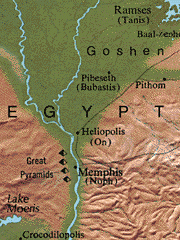 |
|
Heliopolis, the biblical "On" (Genesis 41:45), located just north of the Giza pyramids. Heliopolis was the center of Egyptian religion for thousands of years, possibly for over ten thousand years - or more - before the historic period.
|
(the biblical "On"). As Hancock explains, "When the Pyramid Texts were compiled in the epoch of 2500 b.c., the religious centre of the Pharaonic state was at Heliopolis - the 'City of the Sun', called 'On' or 'Innu' by the ancients, which now lies completely buried under the Al Matareya suburb of modern Cairo.... The Heliopolitan priests were high initiates in the mysteries of the heavens and their dominant occupation was the observation and recording of the various motions of the sun and the moon, the planets and the stars."1
Over thousands of years, the Heliopolitan priesthood had kept careful records of the movements of these astral bodies. Even the Greeks and Romans were in awe of the level of astronomical knowledge the priests of On had acquired. And such great minds as Herodotus, Aristotle, and Plato credited the Egyptians with the invention of the solar year and the zodiac, and also noted that they had accumulated thousands of years of astronomical records, possibly over 10,000 years' worth. Most importantly, they also credited the Egyptians with the discovery of the phenomenon of precession, a concept which requires tens of thousands of years of observation to confirm.
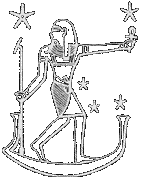 |
|
The god Osiris, as the constellation of Orion. Osiris and his constellation sat at the center of the ancient Egyptian astronomical religion.
|

It was at Heliopolis that the "Shemsu Hor" - "The Followers of Horus" - kept the knowledge of the ancient Egyptian astronomical religion alive for thousands of years. This ancient priesthood, some believe, had lived in Heliopolis for thousands of years before even the beginning of the historic period in Egypt. There they carefully guided the local population, teaching them the arts of astronomy, mathematics, agriculture, and especially architecture, in order to ensure that the ancient astronomical knowledge would continue. The end result of their efforts were what we now know as the pyramids and Sphinx - hieroglyphics in the form of architecture, the ancient astronomical knowledge frozen in stone.
There is significant evidence to support this theory, that ancient Egyptian civilization did not evolve, but appeared in completed form at its inception. As John Anthony West explains,
Every aspect of Egyptian knowledge seems to have been complete at the very beginning. The sciences, artistic and architectural techniques and the hieroglyphic system show virtually no signs of a period of 'development'; indeed, many of the achievements of the earliest dynasties were never surpassed or even equalled later on. This astonishing fact is readily admitted by orthodox Egyptologists, but the magnitude of the mystery it poses is skillfully understated, while its many implications go unmentioned.2
One primary source of information regarding the ancient history of Egypt, the "Turin Papyrus", contains a chronology of the predynastic period in Egypt. What is strange about this list is the mention of the reigns of ten Neteru, or "gods", who reigned for hundreds of years each, for a total of 23,200 years. After this comes a list dedicated to the Shemsu Hor, the Followers of Horus, who reigned a total of 13,400 years. The papyrus then goes on to list the historical kings, those that are commonly accepted as real by mainline archaeology.
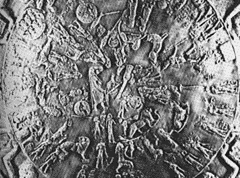 |
|
The "Zodiac of Denderah", located in the Temple of Hathor, in Denderah, Egypt, now on display in the Louvre. Dating from the first century b.c., it details all of the Egyptian constellations. Near the top (and upside down) can be seen the constellation of Aries. Taurus is shown immediately to its right. Leo is below and to the right of the center of the zodiac, treading on a serpent, and below and to the left of Leo one can see Virgo, holding an infant. From E.C. Krupp, Beyond the Blue Horizon: Myths & Legends of the Sun, Moon, Stars, and Planets. New York: Oxford University Press, 1991.
|
Another primary source for Egyptian history, Manetho's History of Egypt, was written in the third century b.c. Manetho, the high priest of Heliopolis at that time, wrote History of Egypt in order to preserve the fast-disappearing Egyptian traditions and culture. Later commentators tell us that it had been divided into three volumes: I. The Gods, II. The Demigods, and III. The Spirits of the Dead and the Mortal Kings. Though the third volume has been used by Egyptologists as the standard reference for the 31 dynasties of Egypt, for some reason the first two volumes have been relegated to the realm of myth and legend.
However, that is not how the ancient Egyptians viewed the Neteru and their descendants, the Shemsu Hor. These beings were believed to be actual historical personages, who formed a formidable prehistory of which we know litte. As Graham Hancock explains in The Message of the Sphinx, "the 'Followers of Horus' may not have been 'kings' in the usual sense of the word, but rather as immensely powerful and enlightened individuals - high initiates who were carefully selected by an elite academy that established itself at the sacred site of Heliopolis-Giza thousands of years before history began."3

Dwelling in Heliopolis, the oldest organized religious center in Egypt (possibly the world), the Followers of Horus sought the answers to eternal life in the stars. Their chief concern was recording the passage of time through intense and regular observation of the sun, moon, stars and planets and their movements through the heavens. This was typical of all ancient religion, but what was most intriguing about their astronomy was that the Heliopolitan priesthood understood the concept of precession, the "Great Year" of 25,920 years. (Click here for a detailed explanation of Precession.) Previously thought to be discovered by the Greeks, new evidence points to the fact that the Egyptians were fully aware of Precession and all of its ramifications for the apparent motion of the stars relative to earth.
In part three of "The Riddle of the Sphinx", we will discuss the effect this knowledge had upon the Egyptian astronomical religion, discover what the Riddle of the Sphinx is, and how Precession is critical to solving this riddle. MW
Notes:
1 Graham Hancock, Robert Bauval, The Message of the Sphinx: A Quest for the Hidden Legacy of Mankind (New York: Crown Publishers, 1996), 193.
2 John Anthony West, Serpent In The Sky: The High Wisdom of Ancient Egypt (Wheaton, IL: Quest Books, 1993), 1.
3 Hancock, The Message of the Sphinx, 193.
|
|
|
|
جواب |
رسائل 6 من 14 في الفقرة |
|
|
|
|
جواب |
رسائل 7 من 14 في الفقرة |
|
Giza Pyramids? Sorry, Not Orion's Belt
Extracts from a new book,
"The Pyramid Builder's Handbook"
by
Derek K Hitchins©
Full copyright and intellectual property rights retained

First, let's see what the stars looked like in 2,500BC. In the graphic above, you can see the stars interconnected to form what, today, we call the constellation of Orion. In the centre of that constellation is the so-called Belt of Orion, made up of three stars: Alnitak, Alnilam and Mintaka. When first learning astronomy, children are taught to use these three stars as a pointer towards Sirius, the brightest star in the sky, which you can see bottom centre, just coming up over the eastern horizon. The grey area is the Milky Way.
Robert Bauval, a Belgian mining engineer, wrote a fascinating book, The Orion Mystery, in which he observed that the three stars in Orion's Belt are not precisely in a straight line, and he noticed, that the Pyramids of Giza were not aligned, either. He saw a similarlty between the stars and the Milky Way on the one hand, and the Pyramids of Giza and the Nile on the other. As if that was not enough, Alnitak was known to be associated with Osiris in the Osirian Legends, and Sirius with Isis, wife and sister to Osiris, and mother of Horus. So was borne the fascinating and romantic idea that the ancient Egyptians of the Old Kingdom were replicating their heaven and their legends on Earth.
Now, I know a lot of people hold to this idea as an article of faith, and it is a beautifully romantic idea, but there are one or two holes in Robert Bauval's idea. Let's look at one or two:-
- Robert Bauval believed that the three stars in Orion's Belt were misaligned in much the same way as the 3 pyramids of Giza. He deduced that the three pyramids were misaligned, because he believed that their diagonals should all be on a straight line. But, the 3 pyramids at Giza are precisely aligned, along their southeast corners. The old aerial photograph and the diagram below show the point, and it is quite clear that the alignement is intentional. Three of the 5th Dynasty pyramids at Abusir are similalry aligned, this time across their northwest corners. Incidentally, the two lines, from the two sets of pyramids, are said to cross at Heliopolis (On, in the Bible), the site of the Sun Temple, in the suburbs of present-day Cairo - but that's another story.
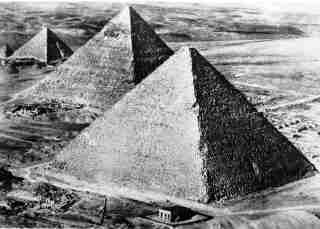
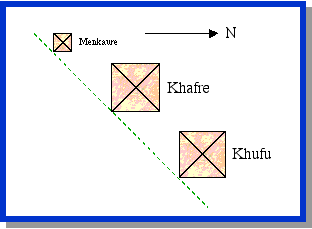
Supposing for the moment that they were trying to map out a group of stars on the Giza plateau, where is Sirius, by far the brightest and most conspicuous star in the sky? In the mythology, Sirius. or Sothis, was associated with Isis, a principal character in the Osirian Legends. Why would such a major star have been overlooked?
Orion the Hunter was a character in Greek mythology, who would not be invented for another 2000 years. Most of our constellation's names are of Greek origin
- At the time of Khufu's Great Pyramid there was no Orion Constellation, no Hunter, no Orion's Belt. Sure, the ancient Egyptians joined up stars to make constellations, but they joined up different stars and made different animals.
- So, no Taurus, no Leo, and no Orion. The ancient Egyptians had a bull constellation, but it was around their then Pole Star, Thuban, and not in today's Zodiac
- The left-hand star in today's Orion's Belt, Alnitak ("the Girdle"), has an Arab name given in the Middle Ages.
- While the star Alnitak, or Sahu to the ancient Egyptians, seems to have been associated with Osiris, there was no basis for the ancient Egyptians to compare the three stars in today's Orion's Belt with the then pyramids of Giza. It's an anachronism.
- By the way, the other two stars in the Belt have names with meanings, too:
- Mintaka means "Belt"
- Alnilam means "String of Pearls" - which suggests that some Arab astonomers, at least, did not see a belt.
Besides all that, there is a perfectly simple reason for the pyramids to be aligned as they are, which has nothing to do with stars or the Milky Way. The Giza Pyramids are aligned as they are so that they can be seen by people - especially kings - travelling down river from Memphis, the ancient capital, to visit their necropolis.

The sequence of pictures shows a 3-D terrain simulation of the Nile Valley, top left, filled with Nile water, top right and viewed from Memphis. The 3 pyramids of Giza can just be seen on the horizon in the top, right-hand corner. Bottom left shows the view some halfway down the river from Memphis to Giza. Bottom right shows the Sun, sinking in the West, and throwing shadows of the Pyramids on to the plateau and the river:-
- Notably, throughout the trip, the 3 pyramids appear to be equally-spaced and right on the visible horizon. This impression is gained because the 3 pyramids are aligned on the corners facing the river, and because they are right on the edge of the scarp.
- This also explains why Menkaure's Queen's Pyramids were placed to the west of the north/south line through his pyramid; by shifting them westwards, they did not obscure Menkaure's Pyramid when viewed coming down the river.
- And, of course, this also explains why Menkure's Pyramid had to be smaller than the other two, since there was only limited space on the plateau for the 3rd pyramid to be aligned. As it was, his Queens' Pyramids had to be cut into the side of the scarp.
To the ancient Egyptians, the horizon was associated with resurrection. The Sun sank below the western horizon each night, only to be resurrected on the eastern horizon each morning. Khufu even called his pyramid Akhet Khufu, Khufu's Horizon, which might be better interpreted as "Khufu's Resurrection". Could it have been that, viewed from Memphis, the pyramid was literally on Khufu's Horizon? If so, Khufu would have been able to watch the progess of his "resurrection machine" throughout the building phase, albeit from a fair distance.
So, it was about spectacle, putting the pyramids on the horizon so that they were visible to the population who were always on or near the Nile. It was also about siting the pyramids in the most propitious spot to be resurrection machines. And, if you think that is an isolated case, check out every other Old Kindom necropolis.

And finally...if you're not convinced, then perhaps these 4 views of the Giza Pyramids will clinch it for you. The first 3 show the pyramids from the River Nile, and the 3 pyramids appear evenly spaced. Note that top right and bottom left show the Inundation in full flood - a view not available today, since the Aswan High Dam prevents the Inundation. The 4th photograph, bottom right, shows the view from the desert - a view no King would normally see - the three pyramids look anything but evenly spaced, not on the horizon, and even Menkaure's Queens' Pyramids intrude at extreme right.
So, there you have it. I would dearly love Rober Bauval's idea of Orion's Belt projected down on to the Giza Plateau to be true - it's a splendid and romantic idea. But, I'm afraid it's not to be...
http://egypt.hitchins.net/the-pyramids/pyramid-myths/giza-pyramids-sorry-not.html
|
|
|
|
جواب |
رسائل 8 من 14 في الفقرة |
|
|
|
|
جواب |
رسائل 9 من 14 في الفقرة |
|
|
|
|
جواب |
رسائل 10 من 14 في الفقرة |
|
|
|
|
جواب |
رسائل 11 من 14 في الفقرة |
|
|
|
|
جواب |
رسائل 12 من 14 في الفقرة |
|
|
|
|
جواب |
رسائل 13 من 14 في الفقرة |
|
|
|
|
جواب |
رسائل 14 من 14 في الفقرة |
|
|
|
 أول
أول
 سابق
2 a 14 de 14
لاحق
سابق
2 a 14 de 14
لاحق
 آخر
آخر

|



![O28 [iwn] iwn](http://bits.wikimedia.org/static-1.24wmf3/extensions/wikihiero/img/hiero_O28.png)
![W24 [nw] nw](http://bits.wikimedia.org/static-1.24wmf3/extensions/wikihiero/img/hiero_W24.png)

















 gyptian religion, like every other ancient religion, was a religion filled with myths and magic, gods, and demigods. However, despite the multiplicity of deities in their ancient religion, and the prominence of fertility rituals in Egyptian rite and cult, the central basis of ancient Egyptian religion was not sexuality, but astronomy. Though sexuality would later come to dominate Egyptian religion, as ignorance and decadence slowly infected the ancient wisdom of Egypt, ancient Egyptian religion was, at its core, astronomical. All the priests of ancient Egypt were master astronomers, as all the deities of ancient Egypt found their homes not only on Earth, but also in the heavens, in the form of constellations.
gyptian religion, like every other ancient religion, was a religion filled with myths and magic, gods, and demigods. However, despite the multiplicity of deities in their ancient religion, and the prominence of fertility rituals in Egyptian rite and cult, the central basis of ancient Egyptian religion was not sexuality, but astronomy. Though sexuality would later come to dominate Egyptian religion, as ignorance and decadence slowly infected the ancient wisdom of Egypt, ancient Egyptian religion was, at its core, astronomical. All the priests of ancient Egypt were master astronomers, as all the deities of ancient Egypt found their homes not only on Earth, but also in the heavens, in the form of constellations.










